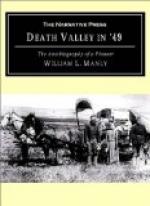I now went to work for Peter Parkinson, who paid me thirteen dollars per month, and I remained with him till spring. While with him a very sad affliction came to him in the loss of his wife. He was presented by her with his first heir, and during her illness she was cared for by her mother, Mrs. Cullany, who had come to live with them during the winter. When the little babe was two or three weeks old the mother was feeling in such good spirits that she was left alone a little while, as Mrs. Cullany was attending to some duties which called her elsewhere. When she returned she was surprised to see that both Mrs. Parkinson and the babe were gone. Everyone turned out to search for her. I ran to the smokehouse, the barn, the stable in quick order, and not finding her a search was made for tracks, and we soon discovered that she had passed over a few steps leading over a fence and down an incline toward the spring house, and there fallen, face downward, on the floor of the house which was covered only a few inches deep with water lay the unfortunate woman and her child, both dead. This was doubly distressing to Mr. Parkinson and saddened the whole community. Both were buried in one grave, not far from the house, and a more impressive funeral I never beheld.
I now worked awhile again with Mr. Henry and we sold our wood to Bill Park, a collier, who made and sold charcoal to the smelters of lead ore. When the ice was gone in the streams, Henry and I shouldered our guns and bundles, and made our way to Milwaukee, where we arrived in the course of a few days. The town was small and cheaply built, and had no wharf, so that when the steamboat came we had to go out to it in a small boat. The stream which came in here was too shallow for the steamer to enter. When near the lower end of the lake we stopped at an island to take on food and several cords of white birch wood. The next stopping place was at Michilamackanac, afterward called Mackinaw. Here was a short wharf, and a little way back a hill, which seemed to me to be a thousand feet high, on which a fort had been built. On the wharf was a mixed lot of people—Americans, Canadians, Irish, Indians, squaws and papooses. I saw there some of the most beautiful fish I had ever seen. They would weigh twenty pounds or more, and had bright red and yellow spots all over them. They called them trout, and they were beauties, really. At the shore near by the Indians were loading a large white birch bark canoe, putting their luggage along the middle lengthways, and the papooses on top. One man took a stern seat to steer, and four or five more had seats along the gunwale as paddlers and, as they moved away, their strokes were as even and regular as the motions of an engine, and their crafts danced as lightly on the water as an egg shell. They were starting for the Michigan shore some eight or ten miles away. This was the first birch bark canoe I had ever seen and was a great curiosity in my eyes.




